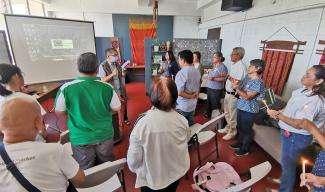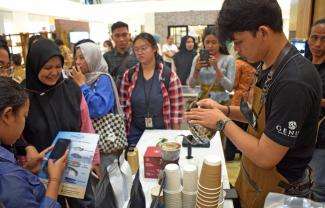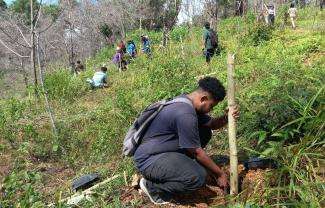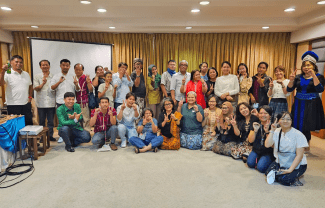Sausapor, Tambrauw - West Papua. March 2, 2015
The elders from 5 tribes in Tambrauw gathered together with government leaders including members of Parliament, CSO/NGO workers and religious elders to discuss customary boundary mapping, clarifying local rights, and the government's development agenda. in Tambrauw. The one day workshop,was organized by the Government of Tambrauw with the support of the Samdhana Institute.
The workshop was conducted in respond to the Bupati Tambrauw's political commitment that Tambrauw be conservation district built on a strong foundation of clear local rights and communication participation. In his opening speech Bupati Tambrauw noted that the issues of sustainable development, rights recognition and community organization are part of his core mission. To realize these goals, his government is providing funding for each tribe in the sub-district to organize internal meetings to discuss rights and boundary mapping. Since 2012 he has supported meetings for four tribes. This is part of his efforts to enhance the benefits of conservation to communities in Tambrauw.
Stakeholders have agreed to soon conduct customary boundary mapping. It will cover the territories of large tribes all the way down to the clan or family group level. “The maps should able to describe both a boundary line and social information about the community. It also should able to describe the land use pattern, places of high cultural and economic value, and long term land needs for housing†noted Ignatius Baru the elders from Fef (Sub District in Tambrauw). The government together with community and other relevant stakoholders needs to do this soon to make sure the development will go smooth without complaint from community.
5 keys recommendation were raised by the elders for consideration by the Bupati:
- Customary community meetings must be conducted in each sub-district in Tambrauw to determine how the customary boundary mapping in clans unit will go. All the budget needed for this meeting must be covered by Tambrauw government's internal Budget.
- A discussion forum between the government, Parliament and customary communities must be well-maintained to re-align the way of thinking about land uses governance in Tambrauw.
- Financial support to all tribes must be provided by the Tambrauw Government to facilitate all customary communities' discussions and boundary mapping both for tribes and clans level to support the government development agenda.
- The parliament as soon as possible should develop and legalize the District Regulation about customary rights protection and recognition in Tambrauw.
- Active collaboration and cooperation between the government, parliament, CSO/NGOs and customary community groups in Tambrauw are crucial to ensuring that all the local rights protection and recognition agenda are optimally done. Official Bupati Decree is needed to frame the team's work and the output that must achieved.
This Workshop was supported by Samdhana, WWF and Paradisea as development partners of Tambrauw District. Customary boundary mapping will be conducted in collaboration with these organizations. The next steps are training for facilitator, field data collection to develop indicative maps, discussion with communities and design of support to tribes/clan territories to produce detailed and definitive maps.




